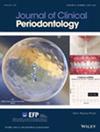采用兔鼻窦模型的临床前研究:同时与分期植入与窦底抬高的愈合效果比较
IF 6.8
1区 医学
Q1 DENTISTRY, ORAL SURGERY & MEDICINE
引用次数: 0
摘要
目的比较上颌窦底增强术(MSFA)与分期入路种植体在骨高度较薄的上颌窦内的组织学愈合情况。材料与方法10只家兔在双侧鼻窦行smsfa,同时在一侧鼻窦置入种植体(SMT组)。4周后,在另一个鼻窦(STG组)放置种植体。8周后对这些动物实施安乐死。进行了显微计算机断层扫描和组织形态学分析。结果在显微ct图像中,种植体被新生骨(NB)和骨替代颗粒很好地包围,两组间新生骨体积差异无统计学意义(p > 0.05)。在组织形态学上,两组间总增强区域内的NB数量和植入物附近的roi无显著差异(p > 0.05)。两组间骨与种植体接触的百分比无显著差异(52.2%±16.6% vs. 44.9%±18.4%;p > 0.05)。结论在骨高度较薄的鼻窦中,同时植入MSFA的x线学和组织学结果与分阶段植入方法相当。然而,这些结果应该在动物模型的背景下谨慎地解释。本文章由计算机程序翻译,如有差异,请以英文原文为准。
Comparison of Healing Outcomes Between Simultaneous and Staged Implant Placement With Sinus Floor Elevation: A Preclinical Study Using a Rabbit Sinus Model
AimTo compare the histological healing between implants placed simultaneously with maxillary sinus floor augmentation (MSFA) and those placed with a staged approach in the maxillary sinus with thin bone height.Materials and MethodsMSFA was performed on both sides of the sinuses in 10 rabbits, followed by simultaneous implant placement in one of the sinuses (group SMT). Four weeks later, implant placement was performed in the other sinus (group STG). The animals were euthanised 8 weeks thereafter. Micro‐computed tomographic and histomorphometric analyses were performed.ResultsIn micro‐computed tomographic images, the implants were well surrounded by newly formed bone (NB) and bone substitute particles, without statistically significant difference in the volume of NB between the groups (p > 0.05). Histomorphometrically, the amount of NB within the total augmented area and ROIs near the implants did not significantly differ between the groups (p > 0.05). The percentage of bone‐to‐implant contact was not significantly different between the groups (52.2% ± 16.6% vs. 44.9% ± 18.4%; p > 0.05).ConclusionsSimultaneous implant placement with MSFA resulted in comparable radiographic and histological outcomes to a staged implant placement approach in sinuses with thin bone height. However, such outcomes should be cautiously interpreted within the context of an animal model.
求助全文
通过发布文献求助,成功后即可免费获取论文全文。
去求助
来源期刊

Journal of Clinical Periodontology
医学-牙科与口腔外科
CiteScore
13.30
自引率
10.40%
发文量
175
审稿时长
3-8 weeks
期刊介绍:
Journal of Clinical Periodontology was founded by the British, Dutch, French, German, Scandinavian, and Swiss Societies of Periodontology.
The aim of the Journal of Clinical Periodontology is to provide the platform for exchange of scientific and clinical progress in the field of Periodontology and allied disciplines, and to do so at the highest possible level. The Journal also aims to facilitate the application of new scientific knowledge to the daily practice of the concerned disciplines and addresses both practicing clinicians and academics. The Journal is the official publication of the European Federation of Periodontology but wishes to retain its international scope.
The Journal publishes original contributions of high scientific merit in the fields of periodontology and implant dentistry. Its scope encompasses the physiology and pathology of the periodontium, the tissue integration of dental implants, the biology and the modulation of periodontal and alveolar bone healing and regeneration, diagnosis, epidemiology, prevention and therapy of periodontal disease, the clinical aspects of tooth replacement with dental implants, and the comprehensive rehabilitation of the periodontal patient. Review articles by experts on new developments in basic and applied periodontal science and associated dental disciplines, advances in periodontal or implant techniques and procedures, and case reports which illustrate important new information are also welcome.
 求助内容:
求助内容: 应助结果提醒方式:
应助结果提醒方式:


